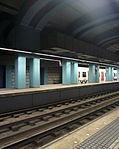Casa Vicens (Catalan pronunciation: [ˈkazə βiˈsɛns]) is a modernist building situated in the Gràcia neighbourhood of Barcelona. It is the work of architect Antoni Gaudí and is considered to be his first major project. It was built between 1883 and 1885, although Gaudí drew up the initial plans between 1878 and 1880. The work belongs to the orientalist style, similar to Neo-Mudéjar architecture, although interpreted in Gaudí’s own personal way, with a uniqueness that only he knew how to add to his projects. In this work, and for the first time, Gaudí outlined some of his constructive resources that would become regular features throughout the emergence of Modernism. The work was widely discussed when it was built and caused a great sensation among the general public at the time. When the building was constructed, Gràcia was still an independent urban nucleus of Barcelona; it had its own council and was classified as a town, though nowadays it is a district of the city.
The original project had a large garden area, in addition to the house, but over time the land was subdivided and sold for the construction of residential buildings. Nowadays, the property has been reduced to the house and a small surrounding area. To take advantage of the space, Gaudí designed three facades, with the house attached by a dividing wall to an adjoining convent. In 1925 an extension of the house was planned, a commission that was offered to Gaudí, which he declined. Instead, he passed it to one of his protégés, Joan Baptista Serra, who built an extension following Gaudí’s original style, with the inclusion of a new facade, resulting in the building being fully detached.
The work belongs to Gaudí’s orientalist period (1883-1888), an era in which the architect made a series of works with a distinctly oriental flavour, inspired by the art of the Near and Far East (India, Persia, Japan), as well as Hispanic Islamic art, such as Mudéjar and Nasrid. During this period, Gaudí used an abundance of ceramic tiling to decorate his work, as well as Moorish arches, columns of exposed brick and temple-shaped or dome-shaped finishes.
The building was declared a Historic-Artistic Monument in 1969, with registration number 52-MH-EN; an Asset of Cultural Interest in 1993, with reference number RI-51-0003823; and a World Heritage Site in 2005, with reference number 320bis.












